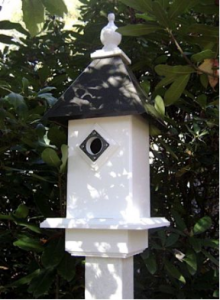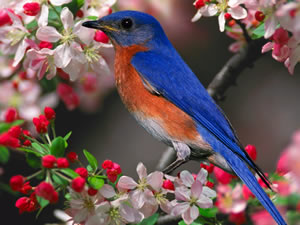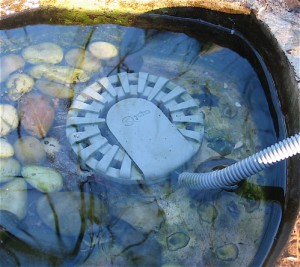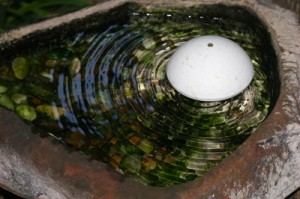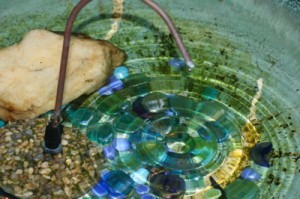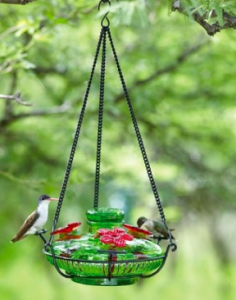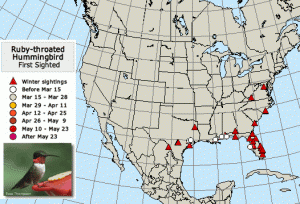-
These Vinyl bluebird houses are NABS Approved
It’s so time to get ready, like yesterday… they’re scouting and building nests already in most parts of the country. Yes, Bluebird season 2012 is here!
If you haven’t done so already, check for old nests in bluebird houses (and other nest boxes too). Best to wear gloves for this chore, and dispose of the nest away from the birdhouse as old nests will attract predators. Clean the box with a mild bleach/water solution (1:10). Scrub, rinse well with water, and let dry in the sun.
The NABS reference above? It stands for the North American Bluebird Society, who gives their approval on certain bluebird houses. The houses must meet specific criteria that’s beneficial to hosting successful bluebird broods and fledges. This is elementary stuff for serious blue-birders, but so many of us are novices and we all have to start somewhere! If you’ve been unsuccessful in enticing bluebirds to your yard, there are lots of great suggestions, and some fantastic information at www.sialis.org. We would strongly recommend this well organized and informative site for anyone interested in hosting blu
ebirds.
Bluebird houses will differ for the Eastern and Mountain/Western Bluebird, although Eastern Bluebirds may use a Mountain Bluebird House. Eastern Blues require a 1-1/2 inch diameter hole, where as Mountain/Western Blues require a 1-9/16 inch entrance. This is where some of NABS Approval comes into play because an entrance that is 1-5/8 inch, will allow Starlings to enter the box, but Starlings can not enter through a 1-9/16 inch hole. Now who would know that? Floor size (4×4 for Eastern Blues, and 5×5 for Western/Mountain Blues) and ventilation are some other criteria for approval by NABS. A predator guard at the entrance of your bluebird house always helps to ensure successful fledges, as does a baffle if the house is pole or post-mounted.
Water, food, and potential nesting spots are key to enticing these fantastic birds! Bluebirds prefer open area for their hunting style (swooping to catch insets), so if your yard is heavily wooded, chance are Bluebirds won’t find it suitable… but other birds will. Chickadees and Nuthatches are already scouting nest boxes and building nests too. We just tried put up one of those side-entry houses supposedly meant for Nuthatches… we’ll see how that goes soon enough.
Spring has sprung early this year, so get in the yard and help local birds thrive!
- Bath Heaters & Deicers, Bird Accessories, Bird Bath, Bird Baths, Birding Accessories, Heated Bird Bath, Misters and Birdbath Drippers, Uncategorized, Water Wiggler
From heated bird baths to moving water in a snap!
It really doesn’t take a bird bath to make a bird bath! Does that make sense? Years ago, this cool rock-like, poly-resin planter caught my eye. Because of the shallow depth, the perfect birdbath set on a tree stump came to mind.
During winter months, this portable bath heater is added quickly and easily, creating one of several heated bird baths in the yard, and the birds use them all!
Today, with the warm sunny weather, and extended forecast for warmer than average temps, the heaters were removed (just as easily) cleaned up, and put in storage for next winter. Out came the water wigglers and bath drippers, which will be in constant use for about, oh, the next eight months or so. Yeah!!
If the birds liked the heated bird baths… they go absolutely bonkers for these fab bird bath accessories! Because moving water is where it’s at as far as birds are concerned. Both resident and migratory birds are attracted to moving water. I like it because bird baths stay cleaner longer, and knowing that mosquitoes can not lay their eggs in my baths is a good thing. Due of the mild winter, it’s going to be a buggy-enough season as it is, and having birds (and bats) around will greatly reduce insect populations the natural way.
If you’re hesitant about having a bird bath with standing water in your yard, you can easily remedy the situation by adding water wigglers, bath drippers or misters to keep water moving and fresher. And, it doesn’t even take a traditional type birdbath, as a deep plant saucer, or shallow dish makes the perfect bath! Two to three inches is the optimal depth. Anything deeper, should have a large rock in the center to serve as a landing spot or perch. With fresh water in the yard (especially moving water), you’ll entice more species of birds, even those who may not visit your feeders.
-
Boiled Hummingbird Feeders?
In anticipation of the great hummingbird migration, all the hummingbird feeders were pulled from storage last night. With the mild winter season we’ve had in the South, the little sprites may be returning earlier than usual this year. Such an endearing and favorite of all our migratory friends, we roll out the red carpet so to speak!
One of the plastic hummingbird feeders was looking a bit cloudy, although it was cleaned prior to storing last season. While making the first batch of nectar (so simple-recipe below) I had the brilliant idea to pour some of the boiling water in the feeder to “clear it up”. The feeder proceeded to melt in my hand… I couldn’t grasp what was happening at first, until I ended up with a Salvador Dali-looking hummingbird feeder! Really should have taken a picture, but was too disappointed in my better judgement. The feeder’s usable for now, but it sure does look funky.
This is exactly why we prefer blown glass or ceramic hummingbird feeders over plastic ones. The quality just can’t be compared. Instead of buying a new feeder every other season, handcrafted hummingbir
d feeders from artists and companies like Parasol and even BirdBrain will last a lifetime. They can be run through the dishwasher for easy cleaning, and they’ll never turn cloudy or yellow over time. The Dali-looking feeder will now be replaced for the last time with this beauty.
Here’s a map showing the first sightings for Ruby Throats in the South and Southeast, with some who’ve even wintered up North. Brave little guys… it won’t be long now! Find the really easy nectar recipe to fill your hummingbird feeders below, they like it better than commercial mixes too 🙂
Mix 1 cup plain table sugar to 4 cups water. NOTHING ELSE, no substitutes as they may be harmful or even fatal to hummingbirds. Plain, Pure Cane Sugar is the only ingredient to use for nectar. No red dye either, it’s a big myth! There’s no need to boil the water, as any organisms spread are by the hummingbirds’ beaks. We do boil one cup of water, simply to dissolve the sugar more effectively. Let cool, fill feeders, and store unused nectar in the fridge for up to two weeks. That’s it! If you’ve never made your own nectar, we encourage you to try it this season, hummingbirds seem to prefer it, and it will be the least expensive bird food all year!

